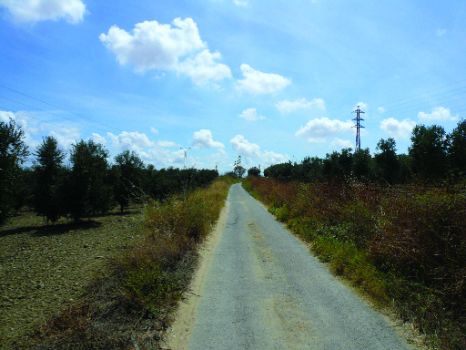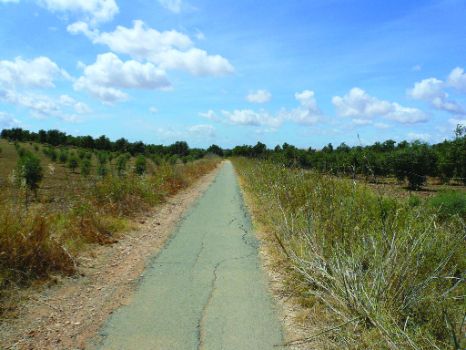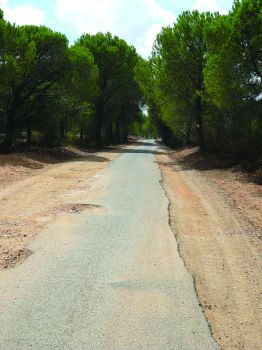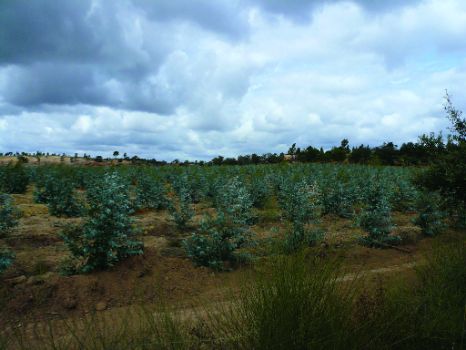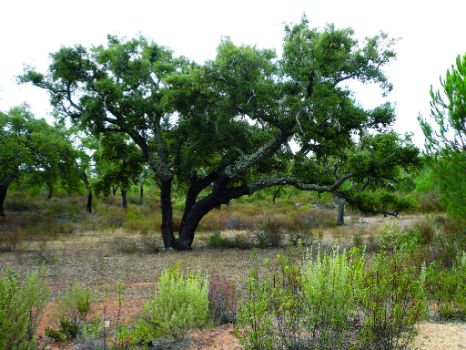Net of Natural
Trails

Los Molinos de Agua Nature Trail
Description
A picnic in the countryside
This corridor runs through the province of Huelva, along the old railway that linked Buitrón Mines with the mining company's pier at San Juan del Puerto, where the route starts.
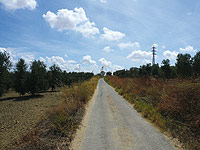
Starting on the outskirts of San Juan del Puerto, on the opposite side of Quinto Centenario motorway, the first section of this Nature Trail first heads towards Trigueros, the landscape dominated by an abundance of olive groves and sunflower fields; hence, one would most likely see Crested Larks (Galerida cristata), Black Kites (Milvus migrans), Montague's Harriers (Circus pygargus) and Common Buzzards (Buteo buteo).
Just before arriving at the town, there is a rest area. The route runs through the town centre, continues along the road that passes under the HU-3105, and heads into the countryside populated with olive groves. Further on the landscape changes to dehesa until it reaches a rest area within a residential estate.
Walking on the road HU-3104 for a hundred meters, the route leaves it by the first exit on the right. The Trail ventures into a pine forest with a few eucalyptus trees (Eucalyptus sp.) which become increasingly more abundant as the path advances. At KM 21, the route crosses the road to Fuente de la Corcha, a small village in the municipality of Beas, and soon after arrives at Apeadero de Pallares.

Eucalyptus and cork oaks (Quercus suber) alternate in this part of the Section, with an increased presence of pine trees (Pinus pinea). The route reaches a bridge over the N-435 and another rest area. From here to the endpoint, the route runs through a pine forest on a paved path in excellent condition, with abundant signposts and a tourist information point.
As the route advances towards Valverde del Camino, the endpoint of this Section, pine trees give way again to eucalyptus and cork oaks. This town is well worth a visit not only for its rich historical heritage, representative of the region's history, including megalithic constructions (Conjunto Dolménico de Los Gabrieles), Roman roads, churches and 19th and 20th century buildings constructed under British occupation (Casa Dirección), but also for its ethnological heritage. Valverde is famous not only for its artisan cabinetmakers or the only traditional bell-making workshop in Andalusia, but also for its long-standing tradition as world-class manufacturers of handmade leather goods.

In addition to the Nature Trail, it is also possible to enjoy one of many hiking trails that start from Valverde del Camino, Beas or San Juan del Puerto. Archaeology enthusiasts may be interested in the "Dólmenes de los Gabrieles" route from Valverde del Camino. The Ruta del Arroyo Candón (Beas) or the Ruta del Muelle y Salinas del Tinto (San Juan del Puerto) may be more suitable for nature lovers. The tourist offices of the Association of Municipalities of Campiña-Andévalo provide detailed information on the routes available in each area.
Managing Entities
Sites of interest
Profile

(Calculated according to the MIDE criteria for an average excursionist with a light load)
Highlights
Further information
Crafts from Huelva’s Andévalo
The one thing common to all the towns lying along the Molinos del Agua Nature Trail is their focus on crafts. The leather industry is the most important economic activity in Valverde. Its flagship product, the "Valverde boot", is footwear especially suitable for outdoor activities. Indeed, it is the key driver of this burgeoning industry. Two other major industries in Valverde are wood processing and furniture production and the copper industry. This town is home to the only workshop in Andalusia where bells and chimes are handmade. Finally, Beas has a remarkable pottery tradition, including earthenware jars, tiles, dishes, kitchenware and other household items.
The original Molinos del Agua Route
The Molinos del Agua Nature Trail gets its name from a nearby route in the town of Beas, which runs parallel to the Trail and Los Molinos Creek. This 1.5-kilometre route starts in a recreation area, and can only be made on foot. There are seven watermills along the route: two of which have been restored -Molino de la Llave and Molino de La Nicoba or Bonifacio.



